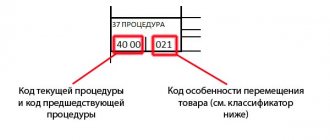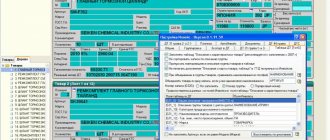Knowledge of laws saves us from many problems, including financial ones. Therefore, even transactions that seem harmless at first glance must be properly formalized from the legal side. Those who have more money turn to the services of lawyers and notaries, but you can save money if you spend your time figuring out all the nuances.
This also applies to purchasing a car or its individual elements abroad. In order to take into account exactly what vehicles and power units are imported into the country, mandatory registration of a customs declaration has been introduced. This is the abbreviated name for the cargo customs declaration, which is necessary for transporting the body or engine of a car.
What is GTD and how is it deciphered?
Cargo customs declaration - this is the abbreviation for cargo customs declaration. Some people periodically face the need to fill out this document, but most of us do not need it for the time being.
This declaration is filled out by everyone who transports cargo across the state border. Thanks to it, you can track the entire path of the cargo, from which taxes, customs duties and fees are levied. And it is also one of the tools for controlling export-import operations.
What does this have to do with our cars? Yes, despite the fact that a car is also a product, and if it crosses the border, a cargo customs declaration is also issued for it. This is the first step towards legally purchasing a car, replacing an engine and other operations with a vehicle.
New form of passenger customs declaration in 2021
From February 1, 2021, a new passenger customs declaration form must be used at customs. It can be downloaded in advance, filled out and printed on a printer on both sides of a sheet of white A4 paper. In addition, you can use existing printed forms in A4 and A5 format.
Attention! There is no need to fill out a passenger declaration if the weight and value of the items transported across the customs border does not exceed the duty-free import limit.
The duty-free import limit differs for different types of transport:
- For air transport up to 10,000 euros and 50 kilograms;
- For land, sea and river up to 500 euros and 25 kg;
- International postal items up to 200 euros and 31 kg.
A passenger customs declaration is needed by individuals to declare goods for personal use. An individual, in accordance with Article 260 of the EAEU Labor Code, fills out the PTD if:
- Goods delivered in unaccompanied baggage;
- Goods are delivered by the carrier;
- Goods delivered by MPO;
- Goods delivered in accompanied luggage for which customs duties must be paid;
- Goods delivered in accompanied luggage, but exempt from customs duties;
- Temporarily exported valuables for their subsequent identification upon import;
- Cultural values,
- Personal car;
- Personal car parts;
- Cash or checks, if their amount exceeds $10,000, and the exchange rate corresponding to the time of crossing the border is taken. If the amount exceeds $100,000, then the funds must not only be declared, but also their origin must be indicated, and supporting documents must also be provided, with the exception of traveler's checks;
Procedure for filling out cargo TD
Since the cargo customs declaration is a financial document, the responsibility for the correctness of the information specified in it lies with the one who fills out the form. Accordingly, there should be no inaccuracies, inconsistencies with data from other documents and sources, corrections or omissions.
The declaration form consists of two parts: TD1 and TD2. Each of them, in turn, consists of 4 self-copying sheets into which the driver of the vehicle enters data. One of the copies remains with him, the original is taken by customs for further processing, the remaining copies go to the archives of statistical authorities and local storage.
Form and main points of the passenger declaration
In paragraph 1 you need to indicate the necessary information regarding the declarant (full name, passport details, address).
In the 2nd point, you need to select the method of travel: accompanied baggage, unaccompanied baggage, Delivered goods without entry or exit. The main differences are contained in the more detailed 3rd paragraph.
In paragraph 3 of the new passenger customs declaration form, which is called “information about goods,” you must indicate:
Procedure: import (free circulation), export, temporary import, transit.
Sub-items:
- 3.1. Cash
- 3.2. Products eligible for discounts
- 3.3. Goods for which the duty-free import limit has been exceeded
- 3.4. Cultural values
- 3.5. Weapons and weapon components
- 3.6. Narcotic drugs, psychotropic substances, etc.
- 3.7. Animals, plants
- 3.8. Collection materials on mineralogy, paleontology, etc.
- 3.9. Samples of human biomaterials
- 3.10. Other goods subject to prohibitions and restrictions and requiring the submission of supporting documents.
The 4th paragraph should contain additional information about the goods specified in the 3rd paragraph. This is the name of the product, its description, weight and cost.
In addition, paragraph 5 “Information about vehicles” has been added to the New Declaration.
At this point you need to select a procedure: import (free circulation), temporary import, export, temporary export, transit.
Indicate the availability of benefits;
Enter data regarding the specific imported vehicle (automobile, motor vehicle, trailer, watercraft or aircraft) or its part that has been replaced.
Basic design requirements
There are few requirements for completing a cargo customs declaration.
- Provide objective data about the cargo and the person transporting this cargo.
- As mentioned above, there should be no blots in the declaration: each corrected error is certified by the signatures of the declarant himself and a representative of the customs service.
- The document contains only the information that it requests, no more.
- The declaration is filled out in Russian, legibly.
Filling out the declaration incorrectly, submitting false information and other errors when filling out the form will force customs officials to detain the cargo for a long time to clarify all the necessary data.
Deadlines for submitting transport tax returns
The transport tax declaration is submitted to the inspectorate after the expiration of the tax period (calendar year). The deadline is no later than February 1 of the year following the reporting year (clause 3 of Article 363.1 of the Tax Code of the Russian Federation). In 2021, February 1 is a Saturday, so the deadline is moved to working Monday 02/03/2020.
Based on the results of the reporting periods, no calculations are required to be submitted to the Federal Tax Service.
The deadline for submitting the declaration and the deadline by which the transport tax must be paid at the end of the year may not coincide. This is due to the fact that specific payment dates are established in regional legislation. For example, in Moscow, a legal entity is required to pay transport tax no later than February 5 of the year following the expired tax period (Clause 1, Article 3 of the Moscow Law “On Transport Tax” dated 07/09/2008 No. 33). And in the Moscow region this deadline is no later than March 28 (clause 1, article 2 of the law “On transport tax in the Moscow region” dated November 16, 2002 No. 129-2002/OZ).
You can find out the tax payment deadlines in your region using the Federal Tax Service service.
ATTENTION! Starting from the tax period for 2021, the deadlines for paying transport tax will be uniform and will be approved at the federal level. For details, see the material “The deadlines for payment of transport and land taxes by organizations are changing.”
What documents are submitted along with the customs declaration?
To confirm the legality of the cargo being transported and the right to transport it, it is necessary to submit the following package of documents along with the cargo customs declaration.
- Confirmation of purchase of goods: purchase and sale agreement (contract) and all documents related to it (invoices, specifications, packing lists, etc.).
- Confirmation of the right to transport: passport, tax identification number, individual entrepreneur documents, certificate of foreign trade participant.
- Certificate of origin and quality of goods from the manufacturer, other licenses and permits.
- Declaration of customs value (valuation) of cargo.
- Receipt for payment of all necessary customs duties.
- Electronic version of the cargo customs declaration on digital media.
Only after all conditions have been met, all documents have been submitted and verified, the declaration becomes valid.
When is a gas turbine engine not required?
The customs declaration is a special transport document consisting of several forms. As mentioned earlier, the declaration must be accompanied by a DTS, which is assigned to goods subject to VAT, excise tax and duties.
When a vehicle or power unit is considered as a load, a TDS is attached to it. However, there are a few special exception cases. Their list is as follows:
- The customs value of the goods is less than $5,000. Economic measures are not applied to this product. An exception is valid in the case where multiple deliveries of goods are planned under one contract agreement.
- The cargo is transported by an individual who does not pursue a commercial purpose.
- We are talking about cargo that is not subject to duties in accordance with the laws of the country.
- A special customs regime, for example, the Customs Union, under which taxation is not excluded.
The customs declaration is an important document accompanying the import and export of cargo (car or power units). To avoid problems in the future, the execution (filling out) of the document should be taken seriously. Only correct execution of a customs declaration can become the basis for creating reliable and safe international transport relations.
How is the declaration number generated?
The customs declaration number is one of the most common questions asked when filling out. This is not just a set of random numbers, but encrypted information, which, if necessary, will give tax authorities quick access to data on the customs declaration.
The number consists of three blocks separated by a slash sign, without letters or spaces. Decoding it is quite simple.
- The first block of 8 digits is the number of the customs office where the customs declaration is issued.
- The second block of 6 digits is the current date in DDMMYY format.
- The third block of 7 digits is the registration number of the declaration.
As is already clear, only thanks to the number you can gain access to these documents, including an archival copy of the cargo customs declaration.
When the tax office receives an invoice for the sale of cargo, its number also indicates the customs declaration number. This is another way to check the activities of a business. Everything must match.
Penalty for failure to declare
According to Article 16.2 of the Code of Administrative Offenses of the Russian Federation, an administrative fine is imposed on a citizen or organization for failure to declare a vehicle. It ranges from 0.5 to two times the cost of the vehicle. Confiscation of the latter is also possible.
If the declaration was carried out late and the regulatory authority did not have time to notify the carrier of prosecution, a fine can be avoided.
If the document itself exists, but it contains false information, the declarant is also responsible. But only if these data led to an underestimation of the amount of duties or exemption from their payment. The violator will pay a fine in the amount of 0.5 to two times the amount of lost duties. There is also a risk of confiscation.
GTD for a vehicle
Well, let's get to the fun part. What is a gas customs declaration for a car, why might it be needed, and what should you do when buying a car from abroad?
GTD for a vehicle
In fact, a car is also a product, and a cargo customs declaration is issued for it. And, as in other cases, the document indicates the details of the seller, buyer, carrier, cost and other necessary data. The car is registered at customs, then all necessary duties are paid, and one of the copies of the customs declaration goes into the package of documents for the car.
Why is this necessary?
Then, in order to protect, first of all, buyers of such used cars. The declaration is a certain guarantee that the car is not stolen or assembled from pieces (this is exactly what scammers do - they import sawn-up cars as spare parts, then weld them back together and sell them).
In addition, a cargo customs declaration is necessary to register a car with the traffic police, since it is a kind of vehicle passport confirming its origin. And here you need to take into account that the slightest inaccuracy in the design of the customs declaration will be the reason for an endless journey through all the “circles of hell” with documents, certificates, invoices and other pieces of paper.
If a car was imported by a legal entity and then sold to an individual buyer, the seller is obliged to hand over, along with other documents, a certified copy of the customs declaration, receipt order and vehicle passport (PTS). Without these documents, registering the car will be impossible (or very expensive).
How can you import a car without a customs declaration?
There are many options, and the main one is the so-called “constructor”, when the body is first sawn, then transported as separate elements, then welded. You can disassemble the body and bring only the frame; it is not subject to mandatory declaration. And then weld new body parts to this frame on site.
Calculation of customs value
Cost indicators can be calculated using several methods. Each of them is designed for specific situations.
| Method name | Calculation method | Features of application |
| Transaction price of transported products | These are the company's actual costs for purchasing products and transporting them. Additional costs are also included. For example, intellectual work or storage expenses. | The method is used only if there is documentary evidence of all included costs. For example, if some expenses cannot be confirmed by invoices or acts, then this method is not recommended. |
| Analogue transaction price | If it is impossible to actually determine the costs of transported inventory items, then this method is used. Its essence lies in the fact that for the calculation, indicators of similar supplies are taken. | An important condition is that the period for importing products cannot exceed 90 days. The lowest economic indicator is accepted for calculation. |
| Transaction price of similar goods | It is allowed to calculate the cost based on the indicators of transactions with homogeneous goods. These are those goods and materials that have similar characteristics and parameters to the transported products. | Only the lowest economic indicators for the market should be taken into account in the calculation. |
| Subtraction | The essence of the method is that additional costs are subtracted from the market value. For example, the calculation involves determining the market value of a similar or similar product, and then subtracting transportation costs, duties, commissions, and profit margins from the amount. | Market value is reduced by additional costs. |
| Addition | The calculated value is determined as the sum of the following indicators:
| Average indicators are included in the calculation. |
| Backup method | Calculated based on data from other exporters. The calculation is made based on information provided by government agencies. | It is considered the least accurate and is therefore used extremely rarely. |
Please note that the calculation methods differ not only in formulas and calculations, but also in the accompanying documentation. For example, only for the calculation method based on the transaction price of transported products, DTS-1 is issued. In all other cases, fill out DTS-2.
Indicators used for calculation
These are the values that directly affect the final result:
- market value of inventory items;
- transportation costs;
- insurance services;
- paperwork;
- additional expenses.
All types of expenses require documentary evidence and/or economic justification. Otherwise, they cannot be taken into account in the declaration of the customs value of imported goods.
In what cases is it not necessary to submit a DTS?
Additional documentation is not required in the following cases:
- transported goods are exempt from customs duties;
- a temporary declaration is drawn up on inventory items, for example, when the carrier cannot provide accurate information about the cargo being transported.
In these cases, DTS is not required. It is enough to send the main cargo declaration to the customs authority.
GTE for engine
You can import not only the entire car, but also individual spare parts and components. And if ordinary auto parts are just an ordinary product that requires standard design, then the engine has its own unique VIN code, which means you can check the path of its life without any problems.
GTE for engine
If an assembled engine is transported across the border, a cargo customs declaration must be issued for it. And it contains the VIN code and other data.
When buying a contract engine, you want to get everything at once and cheaper, but simply installing it to replace a failed one will not work, since its VIN code does not match the code on the car body. Without a gas turbine declaration confirming the “clean” history of the engine, it will not be possible to register it in accordance with the law.
However, even if you have a customs declaration, in order to register a new engine, you must provide other documents: a purchase and sale agreement, a certificate of registration of the seller’s individual entrepreneur, etc. This is the only way to “whitewash” a contract engine and use it without fear of inspections.
Why register?
It is worth understanding that without the State Customs Declaration, any export or import of goods across the Russian border is impossible and is a violation of the law, which in turn can lead to both administrative and criminal liability. Filling out the customs declaration is mandatory for all entrepreneurs, otherwise they will be mistaken for smugglers and their goods will be completely confiscated. It is necessary to fill out, based on all established rules, in order to avoid possible troubles when crossing the border of the Russian Federation.
What to do when buying a used car?
If the seller openly says that the car was brought from abroad, at the same time he must say that he will give a copy of the customs declaration. And this is far from the worst case scenario: normal documents, normal car, normal seller.
The buyer’s task is to inspect the body and check all the VIN codes that he finds (under the windshield, in the driver’s door, under the hood, on the engine). Ideally, all plates with codes are in place, undamaged and contain the same alphanumeric combination.
It is much worse if the code on the body and engine does not match. In this case, the seller must provide two separate cargo customs declarations, and if they are not there, there is no point in dealing with such a vehicle.
And finally, consult with a lawyer and prepare a package of documents for registration of the car. All contracts, identity documents, legal entity documents, etc. More is better than less.
Customs declaration services
provides the following list of services:
- responsible storage of a consignment of goods within the boundaries of a temporary storage warehouse. There are situations when the cargo has arrived at the customs point, but the declaration process is delayed due to incorrect completion or the absence of some documents. Delays may also be caused by technical failures on the part of customs authorities;
- customs transit. Our specialists contact the importer after the cargo arrives at the customs point and coordinate the declaration;
- confirmation of customs declaration - if the value of the cargo is more than 200 euros, contact the seller and agree on all the nuances of filing the declaration. If necessary, informs about the provision of additional documents;
- translation of documents. The staff has a team of translators who will promptly prepare all the necessary papers;
- preparation of export declarations. Applicable to countries with individual export declaration requirements;
- preparation of declarations for a list of goods. Suitable for cases when the client transports several product items at the same time. Specialists classify each unit according to the Commodity Nomenclature of Foreign Economic Activity (commodity nomenclature for foreign economic activity);
- making amendments after the start of the declaration procedure. All information is adjusted according to the documents provided by the applicant. This can be done both during the declaration procedure and after it.
Declaration fields - correct filling
The rules for filling out the declaration fields for export and import are the same:
- The first section indicates the type of declaration, marked with the letters IM (import) or EC (export). In the case of import of goods into the customs territory of the Russian Federation without restrictions on use, the second subsection of the column is entered with code 40. If the document is issued in electronic form, then the ED marker is placed in the third subsection - electronic declaration. In our sample, the declaration is issued in paper form, and this subsection in the declaration is not completed.
- In the upper right corner of the form, in section A, the customs declaration number is indicated; the decoding includes three groups of numbers, under which the customs code, the date of drawing up the declaration and the serial number in the accounting journal are indicated.
- The leftmost section means the declaration form, where the first number 1 means that this is the main sheet - TD1, and the second indicates the number of additional sheets. If they are not issued, 1/1 is entered.
- Column 4 is completed if loading specifications are present.
- The fifth and sixth columns indicate the total imported goods and the number of cargo items. In the presented sample - 1 product, 1 place. This is an important indicator; it must correspond to actual transportation.
- The seventh column is filled in if a preliminary declaration has been carried out, and the design features are indicated. It is filled out by customs.
- 2 columns - sender, 8 columns - recipient. Full names, legal address are written, the country of departure and receipt is indicated in the form of a code in accordance with the rules of customs clearance.
- Column 9 indicates the person responsible for the finance. the settlement is usually the counterparty to the contract. May be the same as the recipient of the shipment.
- Column 12 indicates the total amount of delivery. 22 and 23 - indicate in what currency the delivery is made, with codes of the contract currency and the exchange rate on the date of registration of the declaration.
- Field of column 20 - terms of delivery - is filled in according to the information provided by the contract documents. The delivery location is recorded here. In our case, these are the CIP terms of Incoterms, which means that transportation and insurance of cargo is paid up to a certain point along the route. Maybe to the border, to a warehouse, in our case - to a customs warehouse in Moscow.
- Columns for indicating payments and duties. Each indicator is indicated in its own column: customs duties - 1010, duties - 2010, VAT - 5010.
Below is a sample of the complete filling out of the customs declaration for imports: a breakdown of the columns indicating the completed information.
More details about the rules for filling out declarations, including in electronic form, can be found in the video below.
Registration of a customs declaration at customs: why is it necessary?
The paper described in the article contains several functions. For a better understanding, it is worth examining each of them in detail. First of all, this is obtaining important information. Participants submit it to customs, thereby confirming the fact of the transaction.
The second purpose is legal. The presence of a properly drafted document is evidence that the agreement was reached taking into account applicable national laws and regulations.
The third role is statistical. The data that was identified in the GDT declaration is used by company management to generate a report, identify strengths and weaknesses and make new large-scale decisions.
If we summarize all of the above, we can conclude that paper plays a big role at all stages of international trade. Without it, it will not be possible to draw up a schedule and certify the legality of actions.









